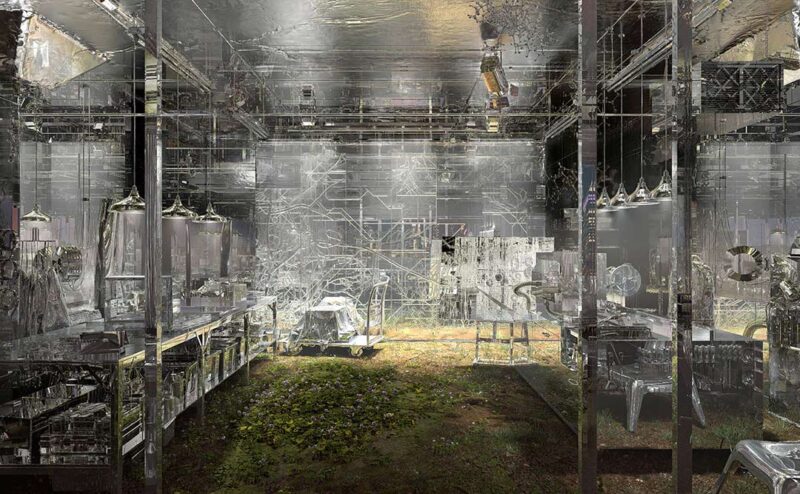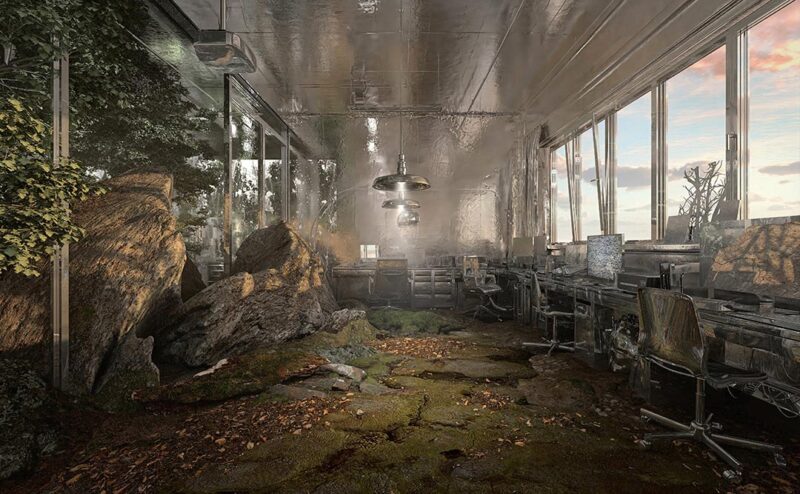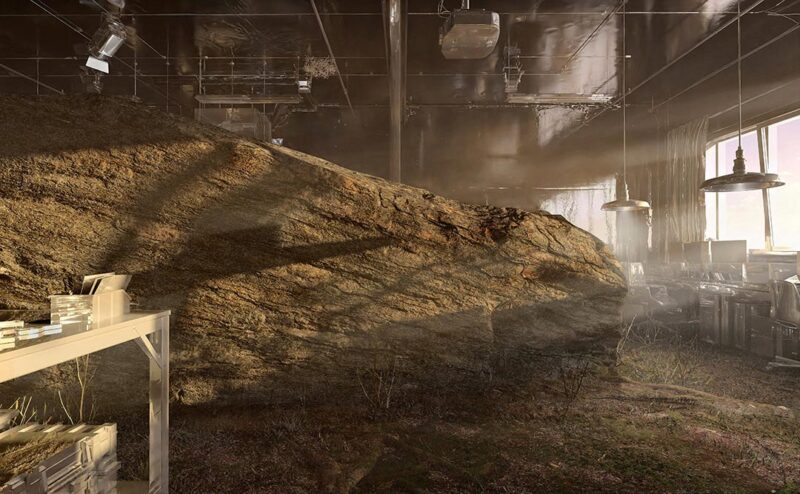[Fall 2023]
[Excerpt]
An Almost Spontaneous Appearance of the Machine in the World
An interview by Jacques Doyon
On the occasion of Nicolas Baier’s major exhibition held in Montreal in early 2023,1 we sat down with him to talk about its main themes.
Jacques Doyon: It seems appropriate to start with the video titled Vases communicants, a high point of the exhibition – if not its anchor point – the title of which was borrowed for the exhibition as a whole. It features vast workshop-office spaces with shiny surfaces (modelled on three-dimensional works that you’ve made before) gradually being taken over by nature that’s both luxuriant and menacing. We find ourselves in a maelstrom of materials, natural or fabricated, that look both realistic and unreal, as if we’ve been swept up in a kind of magma. Can you talk in detail about this work, what we’re looking at and how it was made, and about how it both contrasts and melds the constructed and the natural, the real and the virtual? Is it an allegory for a catastrophe to come or, on the contrary, a great mass of particles percolating?
Nicolas Baier: In fact, it’s not a question of “nature” taking over. It simply exists. I show it.
The effect you describe is no doubt due to the parallel editing of these two scenes, interior and exterior. Above all, I don’t want to talk about nature taking back its rightful place. Even in the stills from the video, I see this cohabitation, rather, as an equivalence, as two forms – disparate at first glance – displaying the same weight, each of them on one of the two platters of a single scale. I like to see it as a nod to the allegory of Plato’s cave.
In the video, the sun lashing the reflective surfaces of the walls and all the things (we don’t see the sun directly, only its reflection) is a reminder of the shadows and light flickering in the cave. Also, we can think about prehistoric cave paintings – in a way, caves were the first studios. I deliberately made sure to insert and highlight the four elements: fire, air, earth, and water.
Over time, I realized that the recurrent use of the studio as a subject in my work is analogous to movie directors constantly returning to an actor they’re obsessed with. As far as I’m concerned, the studio is an icon. It’s where ideas are manifested, where research is conducted, and where a reasonable yet informal mixture is uncovered and made real. In this sense, it’s an emblematic, almost mythical space. The studio is the absolute command post: everything is tucked in there – each decision, each attempt, each thought – so much so that over time it’s easy to get fooled into thinking that everything is born there, everything happens there, that it’s an extension of the mind. In fact, this perception is greatly exaggerated. Obviously, only a few questions, a few themes, chosen here and there, filter through, with the resources available, in an endeavour that often looks more like do-it-yourself than seriously disciplined work. I have the feeling that we capture only the reflections of things – that the traces, the shadows, and the essence evade us, constantly. That’s why I use mirrors in this video. They let me emphasize this observation.
With the mirrors, the gaze is under tension, skewed, it can’t rest or stop at an end point. It never gets a break. The eye endlessly ricochets off edges, off the walls of things, so it can rebound on other surfaces, everywhere it goes, in a constant coming and going, a perpetual mise en abyme. Our comprehension of the area and the concept of a place resurfaced like this is blurred by the incessant play of reflections that emanate from each plane.
By definition, the studio is a space for thought, where you consider the concrete, where you point to and focus your attention on a chosen segment of reality. So, the studio is a mirror: of reality, of what’s happening, of the “there is.” Some days, I admit, that I feel like I’m chained or imprisoned there, and that my understanding of what is around me is completely coloured by that space. Like with the mirror and the cave, there is this play on recording and projection that takes place there every day.
Despite this, the world of ideas is omnipresent and, as in Plato’s allegory, it is mainly somewhere else, outside, always elsewhere. In the video, I chose the forest to evoke the incommensurable totality of what exists. It seems to me to be a logical choice. It’s a good illustration of the fairly common, widespread idea of nature (and all its possibilities): it’s inclusive, it encompasses everything, nothing eludes it – land, water, elements, flesh, thoughts, planets, stars, cosmos, machines. The forest is also probably our earliest habitat, our original home. They say that we descended from trees. If there is one place on Earth we’ve been associated with, intrinsically, since our first unsteady steps, it’s the wooded expanse.
I wanted to juxtapose these two worlds – reality, the world of possibilities – and also our genesis (represented by this forest) and a place to think about it, almost beyond the world, equipped with the latest technologies, machines, and robots (the studio). So, although we often think of nature and technology confronting one another, all I can see is a history, an extension of one by the other. These two spaces (they could be the same geographic place, only many years apart) reflect and respond to each other over time. One is “virgin” land where human beings must find their bearings and struggle to survive; the other is a space where everything, without exception, has been created and produced by humans to meet their needs.
The soundtrack helps this juxtaposition become a superimposition. We don’t know exactly what we’re hearing: is it rain, drops of water hitting leaves, or fingers tapping on keyboards? Is it thunder or a rumbling machine? In fact, the soundtrack is a mix of several live recordings in situ (in the jungle, beside streams or rivers, in fields and forests, in the studio, with all the machines) and traditional sound effects, which are all tricks and subterfuge, in order to mix up the tracks and blur the references.
I didn’t want the forest to be threatening. Under most forest canopies with dense foliage, it’s quite dark even in full daylight. The video is imbued with this very specific luminosity – dusk, the blue hour, when day is melting into night and vision begins to fade. The end of the video shows the reflection of a starry sky, after a long travelling-forward shot, on a work table. The table is in a forest clearing. It’s a bit like Kubrick’s monolith. It was a way to open the outcome to the field of possibilities. In the studio, the table is generally where everything becomes real, where ideas take shape, after many stages of making and modifying.
The film is entirely drawn (generated) and not filmed (captured). It was not a simple solution. The list of objects to be modelled seemed infinite. I didn’t want to point; I wanted to suggest. This difference, between capture and reproduction, is important. When you draw, you learn about and comprehend of the object observed. The process makes it easier, for both the drawer and the spectator, to enter the world of ideas, the world of imagination. Often, unfortunately, I see the camera only for what it is: a tiny opening, a unique point of view, a simple hole in a box. Used excessively (more and more), it’s an almost mind-numbing tool.
jd: The exhibition includes thirty-five other pieces, including seven inkjet prints from the same universe as that of the video…
[ Complete article, in digital version, available here: Nicolas Baier, Vases communicants — An Almost Spontaneous Appearance of the Machine in the World, Jacques Doyon ]
[ Complete issue, in print and digital version, available here: Ciel variable 124 – SEEING THROUGH IMAGES ]



